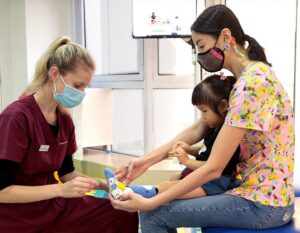
Hand Food and Mouth Disease (HFMD) seems to be an ever-present concern at preschools and swimming pools in the Little Red Dot, and it’s an awfully scary name for something that affects little ones. Never fear, mamas, our brilliant microbiology expert Ellen Loveday is here to arm you with info to fight this all-too-common problem!
One day your child comes home with an illness – “Hand Foot and Mouth Disease”. It sounds scary, but is it really?
Hand Foot and Mouth Disease (HFMD) is an extremely common childhood illness, caused by a highly contagious intestinal virus (coxsackievirus A16 or enterovirus 71). There is more than one strain of both viruses, meaning we can get HFMD more than once as we can only process antibodies one strain at a time.
The disease is named Hand Foot and Mouth Disease because the symptoms occur mainly in the mouth and on the hands and feet. The disease is predominant in children under the age of 5 years old, but also among adult carers.
The viruses thrive in warm humid climates (just like Singapore!). This is why we are privy to the disease all year round. Outbreaks occur in childcare facilities, schools, and even in swimming pools. So what is the low-down? Read on to find out about how HFMD is spread, symptoms, treatment choices, and long-term effects or complications.
How it’s spread
Spread of the disease is by saliva, mucous (nasal), feces or blister fluid. The importance of hand washing and isolation from other children during this period is high. Swimming pools can be a breeding ground as the chlorine levels deplete and the virus spreads.
Use this time to do a spring clean of toys, blankets, door handles, light switches and hard surfaces where germs can thrive. The most effective solution for this job is a disinfectant such as, ‘diluted Dettol disinfectant – 1:9 dilution factor’. Don’t forget to dilute, as the disinfectant is not active without this important step.

Image sourced via Vitacost.com
Symptoms
Contamination period is the most contagious during the first week of the illness, or the whole duration of the illness (3-7 days).
Symptoms start as fever, sore throat and a general unwell feeling (similar to flu). After day two, red rashes become blisters usually found in the mouth or on the feet or palms.
Sometimes the blisters/rash can be found on the knees, buttocks, and genitals.
Treating HFMD
Treatment of the disease is very easy. Pain relief or fever medication is encouraged (not aspirin for children). If needed, a numbing throat spray such as Chloraseptic is recommended as your child will be in pain and may not want to eat or drink.
In addition to the discomfort of the blisters in the mouth, your child may have a fever or a skin rash. Try a bath with Pinetarsol solution to ease the skin rash, and Panadol for fever relief.
Long-Term Effects and Complications
Ongoing complications mainly result from dehydration. Make sure the child resumes fluid intake ASAP to suppress symptoms from the blistering mouth, to provide some cooling comfort, and to avoid dehydration.
Another [highly uncommon – approx. 1.9%] complication is Encephalitis (swelling of the brain). Don’t get too worried, mamas — Encephalitis can be a complication of any virus. Just be aware of your child’s symptoms and seek medical assistance if headaches continue, the child becomes confused, experiences seizures or has problems with movement.
Now we can comfort our children with confidence, mamas!
Top image sourced via Shutterstock
References
CDC. (2013) Hand, Foot and Mouth Disease (HFMD). National Center for Immunization and Respiratory Diseases (NCIRD), Division of Viral Diseases. Internet site. Last viewed 6/11/14. Available: www.cdc.gov/hand-foot-mouth/index.html
Reckitt Benckiser, Dettol. (2014) Dettol Disinfectant Liquid. Internet Site. Last viewed 6/11/14. Available: www.dettol.co.uk/products/pourable-liquids/dettol-disinfectant-liquid/
Zou, Zhang, Wang (2012) Etiologic and Epidemiologic analysis of Hand, Foot and Mouth Disease in Guangzhou city: A review of 4753 cases. Brazillian Journal of Infectious Diseases. ISSN 1413-8670. Internet site. Last viewed 9/11/14. Available: www.dx.doi.org/10.1016/j.bjid.2012.08.001






 View All
View All





 View All
View All










 View All
View All





